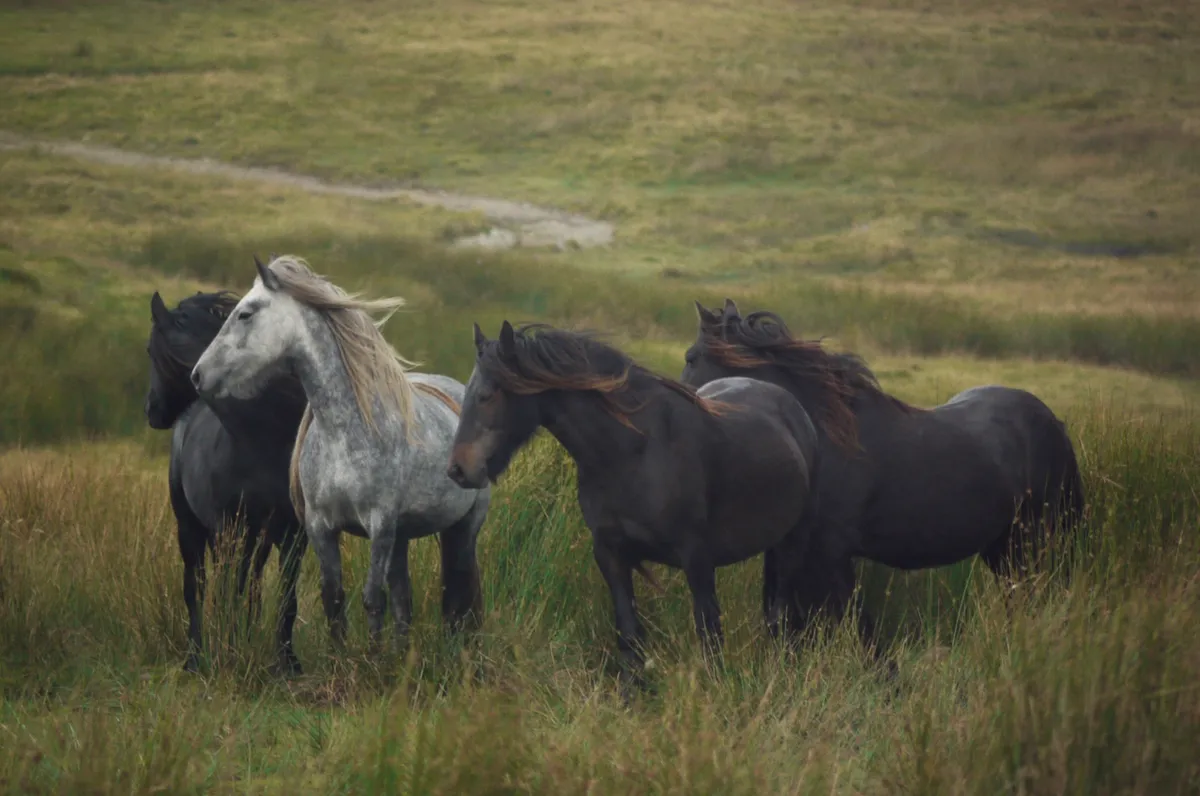Our guide to Britain's native pony breeds, including where they live and how to identify them.
Fell pony

This old breed of versatile mountain pony has long roamed the hills of Cumbria. Fell pony breeders named their studs after the village, farm or fell where they lived, such as Greenholme, Drybarrows and Lownthwaite. Their natural characteristics and hardiness are a perfect match to this fell environment. The height limit is 14 hands, they are sturdy and well-balanced with a long stride. They are exceptionally alert, with big bright eyes, large nostrils and neat little ears. The body is deep and well muscled with strong legs and hard hooves. They have silky straight hair, known as feathers, around the fetlock and a long flowing mane and tail. Fells are black, brown, bay and grey, with a little white on the forehead acceptable. Find out more about the Fell Pony.
Dale pony
The Dales pony is a large and hardy pony with great stamina. As a result, it was used a lot in the lead mining industry. It is predominantly black and occasionally grey. Also known for its courage and intelligence, the Dales pony was a reliable ally for the British Army during both World Wars. Following World War II, its population was significantly reduced. Find out more about the Dales pony.
Eriskay pony

The Eriskay pony is a Scottish breed with a dense, grey waterproof coat. It has a large head, deep chest and easy-going temperament. Originating from the Western Isles of Scotland, the breed had to adapt to harsh living conditions involving limited food supply and rainy weather. The Eriskay pony was often a domesticated breed used as a children’s mount and for light work. Its remote habitat and inbreeding has left it in a perilous state. Find out more about the Eriskay pony.
Dartmoor pony
The Dartmoor pony is a centuries-old breed widely known for its versatility. Capable of withstanding rough weather conditions, it is a hardy breed with excellent stamina. It was used extensively in the tin-mining industry to carry heavy loads. With a small head and wide-set eyes, it is now often considered to be a children’s pony. A friendly and faithful companion, the breed’s recognised colours are brown, black, grey, chestnut, roan and bay. Find out more about the Dartmoor pony.
Best walks in Dartmoor National Park
This huge moorland scattered with staggering granite tors in the south-east of Devon is a hiker's paradise – discover the best walking routes in Dartmoor National Park with our guide.
Exmoor pony

The Exmoor pony is a short and stocky breed exclusive to Exmoor in west Somerset and north Devon. It is largely brown or bay in colour and is noted for its hardiness and endurance. It is Britain’s oldest breed of native pony and dates back to around 50,000 BC. The Exmoor almost became extinct during the Second World War as many were used as target practice by trigger-happy troops. Find out more about the Exmoor pony.
Best walks in Exmoor National Park
From dramatic coastal footpaths to gentle river walks, there are myriad hikes to be enjoyed in Exmoor National Park – here is our guide to some of the best walking routes.
Highland pony
The Highland pony is, unsurprisingly, a breed native to Scotland. Often known for its large size, the Highland is very hardy and tough; consequently, it was used as a workhorse. It is seen in a wide variety of dun shades. including mouse, yellow, grey and cream. It can also be brown, black, bay and liver chestnut. It is very reliable for jumping, trekking and all-round activities due to its stamina and ability to carry weight. Find out more about the Highland pony.
New Forest pony
The New Forest pony is indigenous to the New Forest in Hampshire. Known for its prodigious speed, the New Forest pony has been a regular racing breed for decades. It is also very hardy and strong. According to breed standards, New Forest ponies may be of any colour except for piebald, skewbald, or blue-eyed cream. Find out more about the New Forest pony.
Best walks in New Forest National Park
New Forest National Park is famed for its beautiful heathland and myriad forest trails – discover its beauty on foot with our favourite hikes.
Shetland pony

The Shetland pony is a breed known for its intelligence and relatively small stature. It is a very strong and sturdy pony used as a workhouse during the Industrial Revolution, mainly to pull carts, carry coal and plough farms. It is considered to be the strongest breed for its size. Nowadays, the Shetland is easily recognised as a children’s pony. It can be seen in almost any colour but is mainly black, chestnut, bay, grey, palomino, dun, roan, cremello, and silver dapple. The breed was exported to the US in the 1880s and the arguably more refined US counterpart is now commonly referred to as the American Shetland pony. Find out more about the Shetland pony.
Welsh pony
The Welsh pony is a breed that traces its origin back to the Middle Ages. It is a very sturdy, sure-footed and intelligent breed. It has been used for various activities over the years noticeably in coal mines and postal routes. Known for its stamina, it is also a very popular choice for trekking, trail riding and jumping. It can be of any colour except piebald and skewbald. The Welsh pony is often crossed with other breeds and as such is at the origin of several new breeds like the Morgan horse. Welsh ponies can be spotted near Snowdonia in north Wales. Find out more about the Welsh pony.